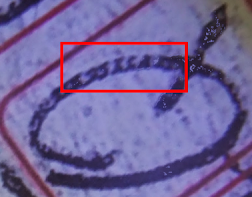Was the TAMAM SHUD Code Page Written With Water?
An earlier method of seceret writing which was both secret ink and indented writing was the most simple and didn't involve the use of chemicals, the 'secret ink' was water. It is possible that the Somerton Man Code page was in fact done in this way, it is still indented writing and the same process of Iodine Vapour treatment could be applied as shown in this 1931 image courtesy of Modern Mechanix magazine.If this was case, the writing could have been applied directly onto the back of the book as recovered with no intervening page.
Apart from Iodine Vapour we have looked at Ammonia as a possibility but the information on Ammonia describes it as a 're-agent' which infers that it promotes a chemical reaction. Some background, the case in point was raised by me when my thoughts were that the 1942 Dasch German Saboteur case was also one where Iodine Vapour was used, that was incorrect as a very uesful comment made by Ralph pointed out, the Dasch evidence discussed Ammonia. Ammonia reacts with Copper Sulphate which was the nature of the secret ink used by Dasch to write in his list of contacts as you will see in the Spy Museum link here..
I am not of the belief that Ammonia was used on the Somerton Man code page, in a discussion during the last week with Gerry Feltus, ex Detective Sergeant of the SA Police and who had the Somerton Man Case in his charge, he was quite certain that part of the process was turning the image of the Code page negative.
The SA Police courtesy of the very experienced Jimmy Durham wrote over the indentations thay had found with what was possibly a form of laundry marker/felt tip pen. My understanding is that such markers were first patented in 1910 by Lee Newman with another style of felt tip being introduced in 1926 by a Benjamin Paskach, this one was referred to as a fountain paint brush, it had a handle and a sponge tip and was available in various colours.
In the same discussion mentioned earlier that I had with Gerry Feltus and on a somehwat morbid note, Gerry recalled writing the name of corpses in the Police morgue on their left shoulder using an indelible pencil. That was an experience we had both had only in my case we wrote on toe tags with a laundry marker. It's amazing how talking with a fellow ex Police officer brings back many memories. One thing we all have in common, apart from hands on experience and the knowledge you gain from it, is that we all recall our observation training. That applies whether you were 'in the job' for one year or twenty, amongst the first lesson you had was how to observe.
Every ex policeman I know has said the same, you are taught thoroughly to observe in detail, whether that's suspicious behaviour or an image that you see or a conversation that you are part of or overhear or in these days, view, you never forget your powers of observation and the details that you then absorb. With regards to conversations, there were often occasions when a 'likely lad' tried their best to confuse issues with a flurry of fine sounding words, a 'snow job' as it was termed; but when you review those conversations and question them you quickly find that they were words without substance, hollow and meaningless and without any form of substantiation. The minute they start to attempt to divert attention to another topic is a sure sign there's something to hide. Signs of a criminal mind? No, not necessarily but quite likely a sign of someone who is out of their depth, dealing with their personal insecurities and struggling to regain acceptance.
The lessons I have learnt from my own experiences have stayed with me and I am sure with others. I hope that visitors to this site will maybe think a little longer and harder when recalling and perhaps viewing discussions as a result. The more you practice the skill, the more it becomes second nature and then we refer to it as 'intuition' or a feeling in the bones but in fact it's nothing more than experiences that all add up and your conclusions are seldom wrong. Once a Copper, Always a Copper :)








Gordon, an old photographic technique used to enhance faint linear edges is to overlay a negative image over a positive of the same image and then put the negative and positive slightly out of register. My father showed me this method many years ago (I was trying to read worn inscriptions on tombstones) and I presume my father used the method for the analysis of aerial photos taken during WW2 reconnaisance missions. I still use the method but many image software programs have "find edges" facility that does essentially the same thing.
ReplyDelete